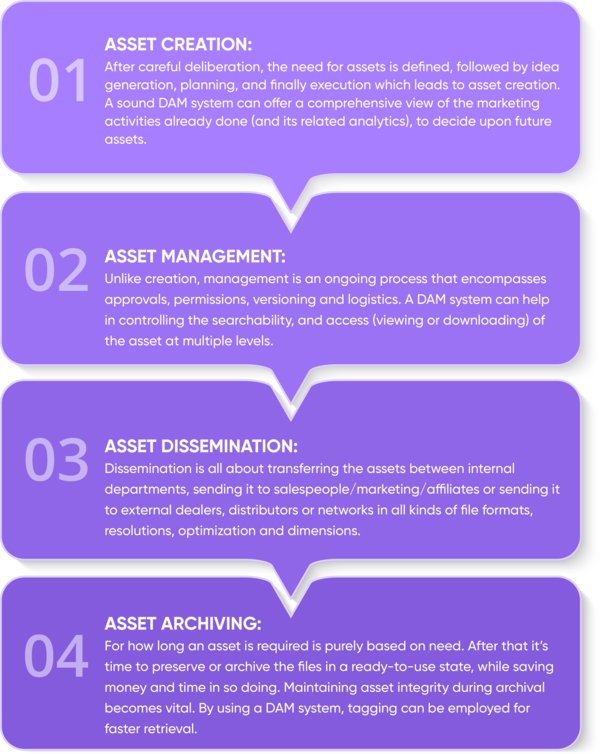Digital Assets: Control Your Through the Entire Content Lifecycle
How to Control Your Digital Assets Through the Entire Content Lifecycle
For upon |As digital media and commercial content distribution continue to proliferate sparing no industry, organizations getting inundated with digital assets are finding it hard to keep an eye on the ball. Lapses in content dissemination, archiving, compliance, and repurposing can make content’s consistency, and time to market take a direct hit, leading to unwarranted financial and productivity losses. If your organization’s in a similar situation, it’s not isolated.
As digital media and commercial content distribution continue to proliferate sparing no industry, organizations getting inundated with digital assets are finding it hard to keep an eye on the ball. Lapses in content dissemination, archiving, compliance, and repurposing can make content’s consistency, and time to market take a direct hit, leading to unwarranted financial and productivity losses. If your organization’s in a similar situation, it’s not isolated. The growing complication in handling the number of digital formats, and increasing automation in Marcom supply-chain and omni-channel distribution are causing ripples, globally.
The time to rethink and reshape a digital asset management strategy is here and now. Organizations on the brink of reaching a ‘critical mass’ in digital content must ensure they make the most of their digital assets by effectively controlling their content lifecycle.
Enterprise Digital Media Lifecycle: The Common Thread
The power of digital asset management (DAM) can only be fully utilized and unleashed when the content lifecycle truly complements the organization’s business process. Broadly speaking, a digital asset lifecycle comprises four key stages:

What DAM Implementation Brings to the Table?
-
Single Version of Truth and Rights Management of Digital Assets
Productivity is often a casualty when users invest more time in looking for digital assets than working on them. Digital asset management ensures a single version of truth for all digital assets while assisting users to organize and save time by using metadata (structured information about data), folders (where existing assets or imports are kept), collections (about ongoing projects), thereby speeding up the time to market.
DAM makes it easy to tag the data you’ve created or purchased. Tracking and controlling access rights is uncomplicated. It happens via metadata fields where data about digital assets like copyright, asset descriptions, usage terms, usage rights, licenses,s and credit certificates are stored.
-
Version Control, Localization, and Asset Searchability
A good DAM system facilitates the tracking of user changes with automatic version control, hence helping maintain a history of assets. This typically addresses things like who worked on the assets, which assets were added recently to the library, and what changes were made to the assets.
Assets accessibility from anywhere on the globe, at any time, is also vital for a DAM strategy to succeed. Once reliable naming conventions are there along with a folder structure that’s intuitive for users, it’s easy to organize workflows.
DAM also brings along advanced search capabilities. Usually, digital assets rely on accurate asset descriptions, tagging, and accurate metadata. Finding assets depends on filtered search results, saved searches, media-centric attributes, multifaceted navigation, and even integration with Artificial Intelligence (AI).
-
Marketing Support, Managing Metadata, and Taxonomy
Delivering assets to the marketing and sales teams, stores, subsidiaries, colleagues, or leadership, without any ado or errors is the primary objective of DAM. It’s often made possible via a brand portal functionality, enabling key persons with rights to access to the brand portal.
Rendition control is another feature some DAMs offer where presets can be created for highly important versions, enabling teams with faster time to market. The final versions of the assets can then be published to the Webshop, Web Content Management (WCM), or Product Information Management (PIM) systems.
Advanced search is also made possible with taxonomy and metadata. They facilitate automated retrieval of technical information with the help of inbuilt technologies such as elastic search or Artificial Intelligence (AI) by tagging all new assets.
-
Workflows, Work in Progress, and Security of Digital Assets
Integration with workflow solutions to evade content holdups during content production is offered by many DAMs. This integration can foster storage/archival and reuse of assets, tracking of association between images, how they’re published, and their maintenance. Due to a single integrated editorial workflow solution, minimal time is spent on long-drawn-out tasks while managing digital assets.
The protection of sensitive and confidential digital assets is a vital component in most DAMs. Security breaches can happen in the form of online theft, hacking, or other multiple ways. Proper checks and balances in digital data security can keep unapproved data distribution or any other leakages in the system at bay, so the enterprise stays immune to losses of any kind.
Lastly, DAM Means One Key Thing—Lowered Costs
DAM’s coming to the fore as the missing piece of the puzzle for enterprises in terms of curbing costs happens on at least three fronts: technology, legal and human resource.
Technology and pricing models are selected according to the organization’s precise requirements; it can be on-premise, cloud, or a private cloud solution.
Managing legality gets easy, as due to clear lines between permissions and rights management, handling licenses, non-disclosure agreements (NDAs), and general use becomes uncomplicated. From a human resource standpoint, automation leads to lean teams and the appointment of only key employees, saving costs on scouting, recruiting, and training resources.
Besides, DAM eliminates the need for repurchasing, reusing, or recreating assets from scratch. Overall, organizing digital assets is a high priority for running operations under stipulated budgets, and DAM’s deployment can be a huge competitive edge for enterprises.
This article was first published here.


Comments are closed.